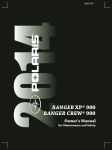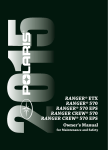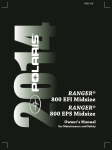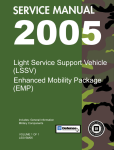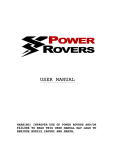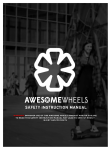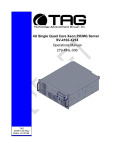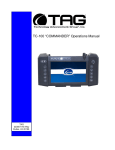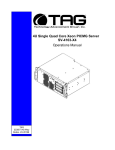Download STRIKE-C/C4 LTV STRIKE-M/M4 LTV
Transcript
(RPAMS) STRIKE-C/C4 LTV STRIKE-M/M4 LTV Supplemental Owner's Manual for Maintenance and Safety 1 Contact Information: RP Advanced Mobile Systems, LLC. 11160 SW Durham Lane, McMinnville, OR 97128 USA Phone: 503-434-9446 FAX: 503-217-6080 Web: www.RPAMS.com 2 WELCOME Welcome to the family of innovative RPAMS upfitted Can-Am based SBS/ATV owners and operators! At RPAMS, we are committed to our many sportsmen, warfighters, agents and allies around the world. Our families of light tactical vehicles are combat proven, providing mobility, sustainability, transportability and mission flexibility to our mobilized warfighter. RPAMS sets the standard of upfit excellence for all utility and recreational vehicles manufactured by BRP Can-Am. Significant effort and years of tactical experience are imbedded in the engineering and development of your RPAMS upfitted vehicle, making it one of the finest tactical platforms produced. For safe and effective operation of your vehicle, be sure to follow the instructions and recommendations in this owner’s manual and supplemental appendices. This manual contains instructions for minor maintenance. Major maintenance and repairs are outlined in the BRP Can-Am Service Manual and should be performed only by a factorycertified technician. For sales, parts, technical information and support, please contact a RPAMS representative or Mike Jackson at the following web site, respectively: Web: www.RPAMS.com Web: www.MilitaryATV.com At RPAMS, we are passionate about producing an exciting line of utility and tactical products for our customers. You can find out more about RPAMS by visiting our web site: www.RPAMS.com 3 [INTENTIONALLY BLANK] 4 TABLE OF CONTENTS 1.0 Introduction . . . . . . . . . . . . . . . . . . . . . . . . . . . . . . . . . . . . . . . . 7 2.0 Safety . . . . . . . . . . . . . . . . . . . . . . . . . . . . . . . . . . . . . . . . . . . . . . 9 3.0 Important Product Labels . . . . . . . . . . . . . . . . . . . . . . . . . . . . 15 4.0 Operation . . . . . . . . . . . . . . . . . . . . . . . . . . . . . . . . . . . . . . . . . 19 5.0 RPAMS Tire Sizes and 4.0 Recommended Tire Pressures . . . . . . . . . . . . . . . . . . . . . . . . 33 6.0 Winch Guide . . . . . . . . . . . . . . . . . . . . . . . . . . . . . . . . . . . . . . . 35 7.0 Maintenance . . . . . . . . . . . . . . . . . . . . . . . . . . . . . . . . . . . . . . . 37 8.0 Warranty . . . . . . . . . . . . . . . . . . . . . . . . . . . . . . . . . . . . . . . . . 41 9.0 Index . . . . . . . . . . . . . . . . . . . . . . . . . . . . . . . . . . . . . . . . . . . . . 45 5 [INTENTIONALLY BLANK] 6 1.0 INTRODUCTION Your RP Advanced Mobile Systems, LLC (RPAMS) upfitted vehicle is a BRP Commander™ or Maverick™ LTV, upfitted by RPAMS with accessories for military and industrial applications. The standard RPAMS upfit kit comprises at a minimum a rear multi-modal bed, ride mitigation seats, high load run-flat tires, MOLLE roof and front push bumper system. The operator must follow the original equipment manufacturers (OEM) manuals for proper operation and maintenance of the base vehicles. The RPAMS manual is a supplement to, and not meant to replace, the OEM manuals. Failure to heed the warnings and safety precautions contained in this manual can result in severe injury or death. Your RPAMS vehicle can be hazardous to operate in certain situations. This upfitted vehicle handles differently than cars, trucks or other off-road vehicles. A collision or rollover can occur, even when conducting routine maneuvers such as turning, driving on hills or over obstacles and acceleration/ braking, if you fail to follow and implement proper operational precautions. All operators must read this manual and understand all safety warnings, precautions and operating procedures before operating the vehicle. This manual should always be kept in the vehicle. For additional safety information and training, visit the Recreational Off-Highway Vehicle Association web site (rohva.org) and take the free on-line training course. 7 1.0 INTRODUCTION Vehicle Identification Numbers Record your vehicle's identification numbers in the spaces provided below. Vehicle Identification Number Engine Serial Number Engine Serial Number:_________________________________________________ Vehicle Identification Number:_________________________________________________ Vehicle Model Number:_________________________________________________ 8 2.0 SAFETY 2.1 Signal Words/Symbols Signal words/symbols appear throughout this guide. Your safety is involved when these words/symbols are utilized. Failure to operate this vehicle properly can result in a collision, loss of control, accident or rollover, which may result in serious injury or death. Heed all signal words/symbols and safety warnings outlined in this section of the manual. Your safety, and that of others, depends on it. Review the descriptions below before proceeding further: The safety alert symbol indicates a potential personal injury hazard. “DANGER” - A DANGER indicates a hazardous situation that, if not avoided, will result in death or serious injury. “WARNING” - A WARNING indicates a hazardous situation that, if not avoided, could result in death or serious injury. “CAUTION” - A CAUTION indicates a hazardous situation that, if not avoided, could result in minor or moderate injury. “NOTICE” - A NOTICE indicates a situation that could result in property damage. The Prohibition Safety Sign indicates an action NOT to take in order to avoid a hazard. The Mandatory Action Sign indicates an action that NEEDS to be taken to avoid a hazard. 9 2.0 SAFETY 2.2 Operator Restrictions/Age Restrictions This vehicle is intended for ADULTS ONLY. At a minimum, you MUST be at least age 18, properly trained by an accredited operator course and have a valid driver’s license to operate this vehicle. All operators must read and understand this manual and all warning and instruction labels before operating the vehicle. Never allow anyone to operate this vehicle until the person has completed the same training. Make sure all passengers are tall enough to sit comfortably and safely, reach the provided hand holds and place both feet on the floor within the cab. 2.3 Seat Belts Always wear properly fitted seat belts when operating or riding in this vehicle. Riding without seat belts increases the risk of serious injury in the event of rollover, loss of control, other accident or sudden stop. Seat belts can reduce the severity of injury in these circumstances. All vehicle occupants must wear seat belts at all times. 2.4 Using Alcohol or Drugs Riding in this vehicle after consuming alcohol or drugs could adversely affect operator judgment, reaction time, balance and perception. Never consume alcohol or drugs before or while operating or riding in this upfitted vehicle. 10 2.0 SAFETY 2.5 Operating Without Instruction Operating this vehicle without proper instruction or training increases the risk of an accident/incident. The operator must understand how to operate the modified vehicle properly in different situations and on different types of terrain. RPAMS strongly recommends taking a training course and completing the associated test to verify driver/operator proficiency. 2.6 Safe Riding Gear Riding in this vehicle without wearing an approved helmet and protective eyewear increases the risk of serious injuries in the event of an accident/incident. Operators and all occupants must wear a helmet, eye protection, gloves, protective apparel and over-the-ankle boots. Helmet Wearing a helmet or appropriately certified head protective gear can prevent a severe head injury. Whenever riding this RPAMS upfitted vehicle, always wear a helmet that meets or exceeds established safety standards. Approved helmets in the USA and Canada bear a U.S. Department of Transportation (DOT) label. Approved helmets in Europe, Asia and Oceania bear the ECE 22.05 label. The ECE mark consists of a circle surrounding the letter E, followed by the distinguishing number of the country which has granted approval. The approval number and serial number will also be displayed on the label. 11 2.0 SAFETY 2.6 Safe Riding Gear (continued) Eye Protection Do not depend on eyeglasses or sunglasses for eye protection. Whenever riding this RPAMS upfitted vehicle, always wear shatter-proof goggles or use a shatter-proof helmet face shield. RPAMS recommends wearing approved Personal Protective Equipment (PPE) bearing markings such as VESC 8, V-8, Z87.1, or CE. Make sure protective eye wear is kept clean. Gloves Wear gloves for comfort and for protection from sun, cold weather and other elements. Boots Wear sturdy over-the-ankle boots for support and protection. Never ride a RPAMS vehicle with bare feet or sandals. Clothing Wear long sleeves and long pants to protect arms and legs. Rider Comfort Under certain conditions, heat generated by the engine mid chassis location and exhaust system can increase temperatures in the cab area. The condition occurs most frequently when a vehicle is being operated in high ambient temperatures at low speeds and/or high load conditions for any period of time. The use of certain cab enclosure systems may contribute to this condition by restricting airflow. Any discomfort due to heat accumulating in this area can be mitigated by wearing proper riding apparel and by increasing airflow. 12 2.0 SAFETY 2.7 Carrying Passengers Never carry a passenger until you have operated this vehicle for at least two hours and have completed appropriate driver training commensurate with the intended mobility mission or vehicle application. A passenger must always be seated in a passenger seat with seat belt secured and within the protection of the roll cage. Never carry more passengers than designed. Carrying Multiple Passengers Never carry a passenger until you have operated this vehicle for at least two hours and have completed appropriate driver training. A passenger must always be seated in a passenger seat with seat belt secured. Carrying more than one passenger in a 2-seat vehicle can affect the operator’s ability to steer and operate the controls, which increases the risk of loss of control and accident or rollover. Never carry more than one passenger in a 2-seat vehicle. Certain conditions (mission critical) will require non-standard passenger transport. In those situations, the operator/unit is required to develop procedures consistent with vehicle limitations and exercise extreme caution. 2.9 Roll Cage The factory installed roll cage is designed for and conforms to ANSI/ROHVA 1.1 for the purposes of recreational use only in original OEM configuration. The RPAMS added modifications and intended high risk military/law enforcement use can potentially exceed the parameters of this standard. Therefore, RPAMS cannot (and does not) guarantee the certified 13 2.0 SAFETY 2.9 Roll Cage (continued) performance of the roll cage kit in event of a roll over. Operators of modified vehicles need to exercise extreme caution when operating the modified vehicle and properly use installed occupant restraints. 14 3.0 IMPORTANT PRODUCT LABELS Any person who rides this vehicle should read and understand this information before riding. 3.1 Safety Labels Read and understand all the safety labels on your vehicle. These labels are affixed to the vehicle for the safety of the operator, passenger or bystanders. The following labels are on your vehicle, and they should be considered parts of the vehicle. If missing or damaged, they can be replaced free of charge. Contact RP Advanced Mobile Systems. NOTE: In the event of any discrepancy between this supplemental guide and the vehicle, the safety labels on the vehicle have precedence over the labels in this guide. 1 TYPICAL 15 3.0 IMPORTANT PRODUCT LABELS 3.1 Safety Labels (continued) 2 TYPICAL SUPPLEMENTAL LABEL 1 16 3.0 IMPORTANT PRODUCT LABELS 3.1 Safety Labels (continued) SUPPLEMENTAL LABEL 2 17 [INTENTIONALLY BLANK] 18 4.0 OPERATION 4.1 Failure to Inspect Before Operating Always perform a pre-ride inspection before each use of your vehicle to make sure it's in safe operating condition. Failure to inspect and verify that the upfitted vehicle is in safe operating condition before operating increases the risk of an accident. 4.2 Operating on Pavement Operating this upfitted vehicle on paved surfaces (including streets, hardened paths, parking lots, and driveways) will seriously affect handling and control of the vehicle, and may cause the vehicle to lose control. This vehicle's tires are DOT rated but designed for off-road use only, not for use on pavement. Avoid operating the vehicle on pavement. If you must operate on a paved surface, travel slowly, make turns cautiously and do not make sudden maneuvers or stops. 4.3 Operating on Public Roads Operating this vehicle on public streets, roads or highways could result in a collision with another vehicle. Never operate this vehicle on any public street, road or highway, including dirt and gravel roads. Be aware that in many states, it's illegal to operate off-road vehicles of this type on public streets, roads and highways. 4.4 Operating at Excessive Speeds Operating this vehicle at excessive speeds significantly increases the operator's risk of losing control. Always operate at a speed that is appropriate for the terrain, visibility, conditions, your operator skills and your other occupant’s skills. 19 4.0 OPERATION 4.5 Turning Improperly Turning improperly could cause loss of traction, control, incur an accident and/or rollover. Always follow proper procedures for turning. Avoid sharp turns. Never turn while applying heavy throttle or brake. Never make abrupt maneuvers. Always consider the payload when turning. Practice turning at slow speeds before attempting to turn at faster speeds. Always follow operational training guidelines. 4.6 Physical Control of the Vehicle Removing hands from the steering wheel, hand hold or removing feet from the floor while riding increases the risk of loss of control and can cause an accident or rollover. The operator should always keep both hands on the steering wheel during operation. Passengers should always be seated in a passenger seat with seat belt secured, with both feet on the floor and with both hands securely grasping the passenger hand hold or grab bar. Keep hands and feet inside the vehicle at all times. 4.7 Jumps, Stunts and Unauthorized Operations Hazardous driving increases the risk of an accident or rollover. DO NOT do power slides, “donuts”, jumps or other driving stunts. Avoid exhibition style driving. 20 4.0 OPERATION 4.8 Descending Hills Improperly Improperly descending a hill could cause loss of control or incur a rollover. Always follow proper procedures for traveling down hills as described in the owner's manual. • Always descend a hill with the transmission in forward gear. Never descend a hill with the transmission in neutral. • Always investigate the terrain carefully before descending a hill. • Never travel down a hill at excessive speed. • Avoid traveling down a hill at an angle, which could cause the vehicle to lean sharply to one side. Travel straight downhill and carefully traverse obstacles while descending. 4.9 Improper Hill Climbing Improper hill climbing could cause loss of control or rollover. Use extreme caution when operating on hills. Always follow proper procedures for hill climbing. 4.10 Crossing Hillsides Driving on a side hill is not recommended under any circumstance. Improper procedure could cause loss of control or rollover. Avoid crossing the side of any hill unless 21 4.0 OPERATION 4.10 Crossing Hillsides (continued) absolutely necessary. If crossing a hillside is unavoidable, always follow proper procedures and always consider the effects of onboard payload/cargo. 4.11 Stalling While Climbing a Hill Stalling or rolling backwards while climbing a hill could cause a rollover. Maintain steady speed when climbing a hill. If you lose all forward speed: • Apply the brakes carefully until the vehicle is fully stopped. • Place the transmission in reverse and slowly allow the vehicle to roll straight downhill while applying light controlled brake pressure to control speed. 4.12 Operating in Unfamiliar Terrain Failure to use extreme caution when operating on unfamiliar terrain could result in an accident or rollover. Unfamiliar and austere terrain may contain hidden rocks, foliage, obstacles and/or holes that could cause loss of control or rollover. Travel slowly and carefully. Use extreme caution when operating on unfamiliar terrain. Always be alert to ever-changing terrain conditions. Adhere to the specific operational training designed for terrain navigation. 4.13 Operating Improperly in Reverse Improperly operating in reverse could result in a collision with an obstacle or person. Always follow proper operating procedures as trained. Before shifting into reverse gear, always check for obstacles or people within proximity of the vehicle. When it's safe to proceed, back up very slowly. 22 4.0 OPERATION 4.14 Improper Tire Maintenance Operating this vehicle with improper tires or with improper or uneven tire pressure could cause loss of control, accident or rollover. Always use the size and type of tires specified for your vehicle and operation. Always maintain proper tire pressure as described on the tire and on safety labels. See Section 5.0, Tire Sizes and Recommended Tire Pressures for specific tire pressures and recommendations. Always consider proper tire selection and maintenance when planning to conduct high payload transport. 4.15 Operating on Slippery Terrain Operating on excessively austere, slippery or loose terrain could cause loss of traction, loss of control, accident or rollover. Do not operate on excessively rough, slippery or loose terrain. Always use extreme caution on austere rough, slippery or loose terrain. 4.16 Operating Over Obstacles Improperly operating over obstacles could cause loss of control or rollover. Before operating in a new area, check for obstacles. Never attempt to operate over large obstacles such as rocks or fallen trees. Always follow the proper procedures as trained when operating over obstacles. 23 4.0 OPERATION 4.17 Skidding or Sliding Skidding or sliding can cause loss of control or rollover (if tires regain traction unexpectedly). Always follow proper procedures for operating on slippery surfaces as trained. When operating on slippery surfaces such as ice or loose gravel, reduce speed and use extra caution to reduce the chance of skidding or sliding. Do not operate on excessively slippery surfaces. 4.18 Operating Through Water Operating through deep or fast-flowing water can cause loss of traction, loss of control, rollover or accident. Never operate in fast-flowing water or in water that exceeds the recommended maximum depth. Always follow proper procedures as trained for operating in water. Wet brakes will have reduced stopping ability. After leaving water, test the brakes. Apply them lightly several times while driving slowly. The friction will help dry out the pads. Be cognoscente of water intrusion into engine intakes and CVT. Follow OEM procedures to properly remove water before further operations. 4.19 Operating on Frozen Bodies of Water Severe injury or death can result if the vehicle and/or the operator fall through the ice. Never operate the vehicle on a frozen body of water unless you have first verified that the ice is sufficiently thick to support the weight and moving force of the vehicle, you and your occupants, and your cargo, together with any other vehicles in your party. Always check with local 24 4.0 OPERATION 4.19 Operating on Frozen Bodies of Water (continued) authorities and residents to confirm ice conditions and thickness over your entire route. Vehicle operators assume all risk associated with ice conditions on frozen bodies of water. 4.20 Operating a Damaged Vehicle Operating a damaged vehicle will likely result in an accident. After any rollover or accident, have a RPAMS or BRP service technician (or appropriately trained operator technician/ mechanic) inspect the entire machine for possible damage, including (but not limited to) brakes, throttle, cargo and steering systems. 4.21 Cargo Load Operation Operating With a Cargo Load on the Vehicle The weight of both cargo and occupants impacts vehicle operation. For your safety and the safety of others, carefully consider how your vehicle is loaded and how to safely operate the loaded vehicle. Follow the instructions in this manual for loading, tire pressure, gear selection and speed. NOTE: The payload limitations are based on vehicles equipped with upgraded high load shocks and 12 ply rated RP SOF Series tires. Any deviation from this configuration requires the payload to be reduced to OEM standard weights as published by BRP Can-Am. 25 4.0 OPERATION 4.21 Cargo Load Operation (continued) Payload Capacity Rear Bed Capacity Optional Front Rack Capacity Strike-C 1,500 lb 1,000 lb 250 lb Optional 4x6 TAG Axle Extension Capacity 1,500 lb Strike-C4 2,000 lb 1,000 lb 250 lb ̶ RP C2 w/BRP Bed 1,500 lb 500 lb 250 lb ̶ Strike-M Strike-M4 1,500 lb 2,000 lb 1,000 lb 1,000 lb 250 lb 250 lb ̶ Model ̶ • Do not exceed vehicle weight capacities. The vehicle’s maximum weight capacity is based on the configuration of the upfitted vehicle (tires, suspension, and multi-modal cargo structure). When more passenger weight is added, cargo weight needs to be reduced accordingly. At all times, both cargo and occupants MUST be properly restrained to prevent unexpected weight shift and subsequent un-desired vehicle movement due to CG movement. • The recommended tire pressures are critical to this capability. Pressures must be checked prior to each vehicle operation. 26 4.0 OPERATION 4.21 Cargo Load Operation (continued) Always follow these guidelines: Under ANY of these conditions: Do ALL of these steps: Occupants and/or cargo exceeds half the maximum weight capacity Operating in rough austere terrain Operating over obstacles Climbing an incline or descending on decline Tow Operations 1. Slow down. 2. Verify tire type and pressure. 3. Use extreme caution when operating. 4. Select lower CVT gear selection Improper Cargo Loading Overloading the vehicle or carrying cargo not properly restrained or exceeding vehicle CG may cause changes in stability and handling, which could potentially cause loss of control or incur an accident. When loading the vehicle, the operator must: • Consider the vehicle configuration and establish weight limits. • Always follow proper instructions carrying cargo. • Never exceed the bed or vehicle load capacity for this upfitted vehicle. 27 4.0 OPERATION 4.21 Cargo Load Operation (continued) • • 4.22 Ensure that cargo is properly distributed and securely attached with appropriately rated restraints. Reduce speed when carrying cargo. Allow a greater distance for braking and conduct careful maneuvers. Transporting In the Rear Bed System In addition to the requirements in this section, the operator must adhere to established industry (or military) standards for proper bed loading procedures. If transporting significant mass loads in the bed, the operator should utilize equipment such as ramps, lifts, shoring and similar equipage specifically designed and load rated for that purpose. As a part of the loading process, the operator should: (1) Turn off the engine and set the transmission to park (utilize chocks as conditions warrant). (2) Ensure the cargo load will not exceed the Gross Vehicle Weight Rating (GVWR) and tire load rating (passengers, tactical/commercial gear, etc.). (3) Inspect the tailgate, tailgate hinges, and tailgate latches for signs of wear that would compromise the structural integrity of the tailgate system. If any signs of wear are identified, replace tailgate system components with manufacturer rated components before beginning to load the vehicle. (4) Inspect the bed track rail system tie down points for signs of wear and stress. Do not use the tie down points if there is any indication that their structural integrity is impaired. 28 4.0 OPERATION 4.22 Transporting In the Rear Bed System (continued) (5) Load heavy items of mass first to maintain the vehicle center of gravity. Build the load from front center and progress aft as cargo allows. Do not load cargo height in excess of the side and rear gate wall structures unless supplemental restraints (nets, straps, etc.) are used and appropriately rated for the cargo weights. (6) Once cargo is loaded in the bed, conduct a thorough inspection to ensure no probability of cargo shift can occur. Also note the weight of the loaded cargo and make any necessary adjustments of the suspension spring rate and preload per the suspension manufacturer recommendations. NOTE: this is extremely critical to ensure safe operations of the loaded vehicle. While the integrated Strike-Kit cargo carriers can increase the ability of the BRP Can-Am SxS to perform varied tasks, the additional complexity requires increased knowledge and caution on the part of the operator. The stability and handling characteristics of the vehicle are affected when operations involve hauling any cargo load. It is essential that operators conducting cargo transport, whether in a cargo carrier and/or an attached trailer, receive appropriate hands-on training in accordance with the requirements of the specific agency or general mobility guidelines. Contact your mobility coordinator, BRP Can-Am dealer or RP Advanced Mobile Systems for specific guidance. 29 4.0 OPERATION 4.23 Strike-Kitted BRP Can-Am SxS Rear Cargo Bed System and Optional Front Cargo Tray The Strike-Kitted BRP Can-Am SxS comes equipped with a rear cargo bed system and optional front cargo tray. They are both designed to carry cargo in a specific manner that varies depending on the cargo and the task. It is important to know the design and load limits the manufacturer has placed on the cargo systems. Operators must: (1) Not exceed the design and load limits of the rear bed (1500 pounds static, low vertical profile, properly restrained cargo or 500 pounds loose bulk) (2) Securely fasten cargo to the cargo carriers (bed or front tray) with an appropriate securement device(s) rated for the total weight of the cargo that connects with the integrated track rail system. (3) Ensure that any cargo extending over the edge or side of the vehicle perimeter will not strike the operator if it becomes entangled with an obstruction. Any supplemental cargo operation must remain within the design limitations set by the manufacturer for any accessory such as trailers or external load devices. 4.24 Blackout Operations The RPAMS vehicle system has an option for “Blackout Operations” if installed. When selected, this option eliminates all displays and illumination generated by the driver MultiFunction Gauge, rear brake lights, rear tail-lights and frontal headlights that could be potentially detrimental to night vision (NVG) specialized vehicle operations. This mode of operation 30 4.0 OPERATION 4.24 Blackout Operations (continued) is activated through switch selection on the center front switch console. CAUTION: selection of the “Blackout Mode” (see picture) eliminates all vehicle external illumination and can be hazardous when operating in vicinity of other vehicles. Use appropriate driving safety measures and exercise constant vigilance to ensure proper margins for vehicle proximity are maintained in order to reduce risk of collision. NOTE: When “Blackout Mode” is selected, the digital power steering is rendered inactive in order to revert steering to manual mode and provide direct terrain input to the driver (rocks, debris, etc.). This is a unique safety feature to allow the operator to have an accurate “terrain feel” during hazardous navigation in low/no light environments. Full steering authority is maintained but through manual reversion. 4.25 Equipment Modifications Your RPAMS upfitted vehicle is designed to provide safe operation when used as directed. Modifications to your vehicle may impact vehicle stability. Failure of critical machine components may result from operation with any modifications, especially those that increase payload, add tactical capability, speed or power. This vehicle may become less stable at speeds 31 4.0 OPERATION 4.25 Equipment Modifications (continued) higher than those for which it is designed. Loss of control may occur at higher speeds and payload. Do not install any equipment on a RPAMS upfitted vehicle that may increase the payload, speed or power of the vehicle, or make any other modifications to the vehicle for other purposes. Any modification to the original and upfitted equipment of the vehicle potentially creates a substantial safety hazard and may increase the risk of bodily injury. The warranty on your RPAMS upfitted vehicle is terminated if any unauthorized equipment or modification has been performed to the vehicle, or if any modifications have been made to the vehicle, that increase its speed or power and/or incur stresses to the vehicle chassis. The addition of certain accessories, including (but not limited to) weapons, mounts, sensors, seats, or large racks, may change the handling characteristics of the vehicle. Use only RPAMS or BRP Can-Am® approved accessories, and familiarize yourself with their function and effect on the vehicle. 32 5.0 RPAMS TIRE SIZES AND RECOMMENDED TIRE PRESSURES 5.1 All RPAMS RP SOF Series tires and tire types are certified to DOT certified cold tire pressure of 20 psi and must be maintained at that pressure for normal driving applications and loads. RPAMS DELTA FX 4-PLY Dune/Desert tire is not DOT certified. 5.2 Proper inflation is the key to tire life and performance. During off road and lower speed applications for specific tactical requirements, tire pressure reductions can facilitate more effective terrain navigation. The following chart provides minimum pressure applications for off road, lower speeds with normal payloads: RP SOF Series & DELTA FX Tires Number of Plies Tire Pressure (in PSI) for Operating Conditions Hard Intermediate Soft Front Rear Front Rear Front Rear Series I, 8- PLY Series I, 12-PLY 14 psi 12 psi 17 psi 15 psi 12 psi 10 psi 14 psi 12 psi 9 psi 5 psi 12 psi 10 psi Series II, 6-PLY 15 psi 18 psi 13 psi 15 psi 8 psi 13 psi Series II, 8- PLY Series II, 12-PLY Series III, 10-PLY Series III, 12- PLY Series IV, 10-PLY Series IV, 12- PLY DELTA FX, 4-PLY 14 psi 12 psi 13 psi 12 psi 13 psi 12 psi ̶ 17 psi 15 psi 16 psi 15 psi 16 psi 15 psi ̶ 12 psi 10 psi 11 psi 10 psi 11 psi 10 psi ̶ 14 psi 12 psi 13 psi 12 psi 13 psi 12 psi ̶ 9 psi 5 psi 6 psi 5 psi 6 psi 5 psi 10 psi 12 psi 10 psi 11 psi 10 psi 11 psi 10 psi 10 psi 33 5.0 RPAMS TIRE SIZES AND RECOMMENDED TIRE PRESSURES 5.3 Do not reduce air below 5 psi on any tire that is not on a beadlock wheel. Vehicles with beadlock wheels and good treaded tires (tires with 50% or more tread remaining) can run at 5 psi, with pressures down to zero psi for short periods of time when utilizing the 12-PLY rated RP SOF Series tires. 5.4 The heavier the vehicle payload, the more care should be taken not to decrease rated tire pressures and risk rolling a bead off the wheel rim. 5.5 The RPAMS DELTA FX Desert/Dune 4-PLY tire is designed for soft sand, off-road recreational applications only, on a standard, non-modified vehicle. If the operator elects to reduce tire pressure below 10 psi, this wheel must be a beadlock to reduce tire to wheel separation. 34 6.0 WINCH GUIDE Your RP Advanced Mobile Systems (RPAMS) Strike-C/C4/M/M4 LTV may come equipped with a 4000 lb. capacity winch manufactured by WARN INDUSTRIES. This accessory adds a great deal of flexibility and functionality to the RPAMS Strike-C/C4/M/M4 LTV. However, the improper use of such devices can be hazardous and may result in property damage and/or injury and potentially loss of life. Never use a winch before reading the winch operating manual and understanding the winch basics and limitations. The operator should familiarize himself with the general safety precautions, basic operations of winching, rigging techniques and winch maintenance. These are found in the WARN RX/XT Winch Line Basic Guide to Winching Techniques manual that accompanies the vehicle owner’s manual of your RPAMS Strike-C/C4/M/M4 LTV. 35 [INTENTIONALLY BLANK] 36 7.0 MAINTENANCE 7.1 CVT Care To ensure optimal operation of newly installed belts, the CVT sheaves must be cleaned of all old belt residue, glazing, and oils. Cleaning can be accomplished by carefully scuffing belt contaminates off the sheave/belt contact area with a mild abrasive such as 220-400 grit sandpaper, Scotch-Brite Pad, or Steel Wool. Follow up by cleaning the surfaces thoroughly with soapy water and or brake cleaner until all impurities have been removed. Cleaning the sheave surface until all contaminates have been removed is vital to future belt and CVT operation. If any particles remain, belt slip and a noticeable drop in vehicle performance can occur. If a belt is to be removed and reinstalled during future maintenance, it is highly recommended that the belt is reinstalled in the same direction as before to match belt wear profile to contact with the corresponding sheave profile. Sheave Dirty Cleaned Sheave 37 7.0 MAINTENANCE 7.2 New Belt Break-In Process New CVT drive belts require a break-in period of at minimum 30 miles to maximize belt life and performance. The goal of the break-in period is to properly wear in the belt to match the sheaves before applying maximum engine torque. By conservatively running through the entire shift range, proper belt contact over the entire sheave/belt contact path is optimized to eliminate belt slippage and drastically increase the belt’s lifespan. Follow these guidelines to accomplish proper belt break-in: (1) Vary vehicle speed and engine RPM to shift belt through normal operational range. (2) Do not exceed ¾ throttle within the first 30 miles of installation. (3) Stop engine and allow belt to cool down every 15 minutes of use. During break-in period, the following activities SHOULD BE AVOIDED: • Aggressive Acceleration or ‘Jerky’ throttle movements at low speeds. • Holding engine/vehicle speed constant for extended time periods. • Pulling Heavy Loads. • Long run times without complete CVT/belt cool down. 38 7.0 MAINTENANCE 7.2 New Belt Break-In Process (continued) By following the break-in process carefully, the belt surface will wear in to match the individual CVT sheaves to maximize grip performance and dramatically reduce heat, glazing, and future wear. 39 [INTENTIONALLY BLANK] 40 8.0 WARRANTY 8.1 RPAMS SxS upfitted vehicle limited warranty applies to new UTV vehicles sold under the trade names Commander StrikeC™, Commander E Strike-R RAPTER™, Commander RP C2™, Commander Max Strike-C4™, Maverick Strike-M™, Maverick Max Strike-M4™ and the Outlander 6x6 StrikeAlpha™, hereinafter referred to as the “Products”, to government military/police/SAR and industrial customers. 8.2 RPAMS provides a limited warranty on its Products upon delivery to the customer and for a period of six (6) months thereafter, where all Products shall be free from manufacturing defects. This limited warranty excludes Products that have been damaged as a result of misuse or improper or inadequate handling, failure to follow the manufacturer’s vehicle maintenance procedures, abuse, failure to use proper lubricant, neglect, accident, fire, or any other cause other than a defect in materials or workmanship. This limited warranty does not cover any vehicle alterations made after delivery to the customer or military/industry applications that expose it to abuse beyond the recreational design applications and intended structural limitations, nor does it cover claims of defective design, unauthorized repairs or use of aftermarket or unapproved components. Damage due to shipping and handling does not constitute a defect under this warranty. 8.3 Set-up of the vehicle and proper vehicle preparation is a key component to ensure proper operation. A part of set-up is the customer completing and submitting the Warranty Registration Form. All warranties are contingent upon RPAMS set-up and the Warranty Registration Form with RPAMS at time of purchase. RPAMS will record the registration and send a copy to the vehicle manufacturer. All warranties are contingent upon 41 8.0 WARRANTY 8.3 (continued) RPAMS vehicle set-up and the customer completing and submitting the Warranty Registration Form. 8.4 It is understood that RPAMS shall only be responsible to repair or replace RPAMS uplifted Products supplied to the customer under this Agreement in accordance with its limited warranty and when the Products have been maintained and operated within the design limitations of the manufacturer. RPAMS shall not be responsible to make any payment, repair, replace or otherwise incur any liability for damages occurring to or resulting from components that are not supplied by RPAMS or its authorized suppliers at the time of sale. 8.6 The warranty for the engine, drive train and steering are as provided by the manufacturer’s warranty. If, upon receipt of the Products or any time within six (6) months thereafter, the customer has a power train or steering warranty condition, the customer shall contact the RPAMS warranty representative within three (3) business days for warranty instructions. RPAMS shall then contact the manufacturer for further instructions. Any modification or alteration of the horsepower, emissions levels, transmission or the exhaust without the manufacturer’s written permission will void any warranty. The Buyer shall assume sole responsibility for the Goods and neither RPAMS nor the manufacturer will in any way be responsible for any failure or damage caused to the Goods or person as a direct or indirect result of their acts or omissions. 42 8.0 WARRANTY 8.7 Warranty support for exported Products. Except where specifically required by law, there is no warranty on this Product when sold outside the United States. 8.8 RPAMS makes no representations or warranties, expressed or implied, with respect to the Products either for itself, or where applicable for the manufacturer, except as may be provided in the written or printed limited warranty offered to the customer with respect to one or more of the Products from time to time. RPAMS reserves its right to amend or rescind the applicability of such warranty at all times. 8.9 THE REMEDIES SET FORTH IN THIS LIMITED WARRANTY ARE THE ONLY REMEDIES AVAIABLE TO ANY PERSON FOR BREACH OF CONSEQUENTIAL OR SPECIAL DAMAGES OF ANY DESCRIPTION, WHETHER ARISING OUT OF EXPRESS OR IMPLIED WARRANTY OR ANY OTHER CONTRACT, NEGLIGENCE OR OTHER TORT OTH OTHERWISE. THE PRODUCTS SOLD BY RPAMS SHALL CARRY NO WARRANTIES OTHER THAN AS STATED HEREIN. IT IS UNDERSTOOD AND AGREED THAT ALL WARRANTIES OF RPAMS, EITHER EXPRESSED OR IMPLIED, INCLUDING ANY IMPLIED WARRANTY OF MERCHANTABILITY AND ANY IMPLIED WARRANTY OF FITNESS FOR A PARTICULAR PURPOSE, ARE HEREBY EXCLUDED AND DISCLAIMED. The exclusive remedy for breach of this limited warranty shall be, at the sole option of RPAMS, the repair or replacement of any defective materials, components or Products. 43 [INTENTIONALLY BLANK] 44 9.0 INDEX 9.1 RP Advanced Mobile Systems (RPAMS) Strike-C/C4/M/M4 LTV come with a number of operator manuals for the vehicle and various accessories. These manuals, listed below, detail the safe operation and maintenance of the RPAMS Strike-C/C4/ M/M4 LTV accessorized vehicle. The owner and operators are urged to read these manuals to ensure safe operation and are provided for the owner’s is built around BRP’s Commander or Maverick SxS include the: • Can-Am Commander™ 800R/1000 Operator’s Guide • Can-Am Maverick™ Max Operator’s Guide • Can-Am Side by Side Safety “Know Before You Go” DVD • WARN RX/XT Winch Line Basic Guide to Winching Techniques™ 45 NOTES 46 11160 SW Durham Lane, McMinnville, OR 97128 USA Phone: 503-434-9446 | Fax: 503-217-6080 www.RPAMS.com Part Number: 500-0003 REV6 47















































